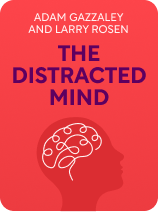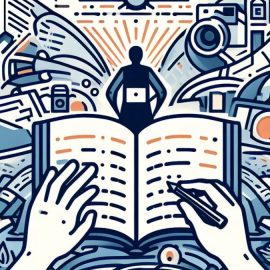

This article is an excerpt from the Shortform book guide to "The Distracted Mind" by Adam Gazzaley and Larry Rosen. Shortform has the world's best summaries and analyses of books you should be reading.
Like this article? Sign up for a free trial here.
Why is technology a distraction? Why are people so vulnerable to technological interference?
The Distracted Mind by Adam Gazzaley and Larry D. Rosen argue that the Information Age increased our susceptibility to interference. They also explain this increase and warn about the harmful effects of this uptick in interference.
Keep reading to learn how and why technology is a distraction, and why anyone can fall for interference.
Interference in the Information Age
Although Gazzaley and Rosen contend that our vulnerability to interference is a longstanding feature of human nature, they argue that it’s been exacerbated by modern technology. In particular, they argue that the Information Age made us more vulnerable to interference by creating information outlets that constantly vie for our attention. To show as much, they first outline how the Information Age increased potential sources of interference and then argue that this new interference has infiltrated our schools and workplaces, which explains why technology is a distraction to younger and older people.
The Information Age, Gazzaley and Rosen argue, began with the onset of the internet around 1990, as information previously only available via encyclopedias became much more accessible. Moreover, the authors point out that the internet led directly to email, which allowed us to communicate instantly with any other internet user.
(Shortform note: Although the internet only began gaining steam in the 1990s, its roots began decades earlier. In 1962 J.C.R. Licklider first articulated his vision of an interconnected network of computers that could communicate with one another, and the US Department of Defense developed the first prototype of the internet in 1969.)
Additionally, the authors argue that two further developments defined the Information Age—social media and the smartphone. First, social media enhanced email’s capacity for communication; whereas before, we could communicate with one person instantly, social media allowed us to communicate with millions of people instantly. Then, with the development of smartphones, we gained access to information from the internet and social media regardless of our location.
The upshot is that interference became exponentially more common as new sources of information—such as email alerts, text messages, and Twitter notifications—began to vie for our attention. Whether in the form of distractions, like the sudden “ding” of a text message, or interruptions, like actively choosing to check social media while at work, we became exposed to interference at every corner.
(Shortform note: This increased interference from the Information Age may vary by country. Although social media and smartphones are generally common in countries with developing economies, certain countries see markedly lower social media and smartphone usage. For instance, while above 80% of US adults use a smartphone, only about 30% of adults in countries like Bangladesh and Pakistan own smartphones.)
Why Does Technology Make Interference More Common?
Having discussed how technology increases interference, we’ll now examine Gazzaley and Rosen’s explanation for this phenomenon. Broadly speaking, they argue that technology leads to widespread interference because we’re evolutionarily wired to consume information, and technology provides easy access to such information.
To explain why our drive for information makes us more susceptible to interference, the authors first discuss the marginal value theorem (MVT)—a theory that predicts when animals will shift from one food patch to another to maximize food consumption—and then suggest that its insights can be applied to our information consumption.
The Harmful Effects of Increased Technological Interference
Now that we’ve seen how and why technology aggravates our distracted minds, it’s time to discuss the impact of this increased technological interference. According to Gazzaley and Rosen, technological interference does widespread harm in various domains of life, including school, the workplace, and our relationships.
Impact #1: Interference in Education
First, Gazzaley and Rosen write that technology has led to widespread interference both in and out of the classroom. According to studies cited by Gazzaley and Rosen, about 90% of college students report using their phones to text while in class—a clear case of interruption (intentional decisions to pursue secondary goals). Moreover, the authors point out that the results are similar outside the classroom: In one study, researchers examined students’ behavior during three-hour study sessions, finding that students checked their phones an average of nine times during these sessions, spending about 30 minutes off task.
According to Gazzaley and Rosen, this technological interference decreases students’ productivity and efficiency. They point out that researchers have found that nearly all forms of in-class technology usage are predictive of poorer classroom performance. Moreover, the authors note that researchers have made similar findings for out-of-class technology usage; for instance, one study found that students who paused to send instant messages while completing an assignment took consistently more time than peers who didn’t (even when accounting for the extra time spent messaging).
Impact #2: Interference in the Workplace
In a similar vein, Gazzaley and Rosen argue that technological interference has also infiltrated the workplace. They cite a study wherein researchers observed office workers for two weeks and found that these workers were interrupted over four times per hour by email and three times per hour by instant messaging. Crucially, 40% of these workers immediately dropped their tasks to respond to emails, while 70% did so to reply to instant messages.
Gazzaley and Rosen argue that workplace interference increases workers’ stress and decreases their efficiency. To show as much, they cite a study of over 200 employees that measured the most significant predictors of employees’ stress levels—behind workload, external interruptions were the greatest predictor of stress levels. Further, as for worker efficiency, Gazzaley and Rosen point to studies showing that workers often take around a half-hour to reorient themselves to their initial task following an interruption or distraction.
Impact #3: Interference in Relationships
Finally, Gazzaley and Rosen write that technological interference has a corrosive effect on human relationships because it inhibits connection. For instance, it’s common to complain that friends are on their phones at dinner rather than conversing with each other. Moreover, the authors note that empirical studies have verified the adverse effects that technology has on relationships. One study found that when two strangers conversed for the first time, they reported feeling significantly less empathy and connection toward each other when a smartphone was lying on a table nearby; this has been referred to as “the iPhone Effect.”

———End of Preview———
Like what you just read? Read the rest of the world's best book summary and analysis of Adam Gazzaley and Larry Rosen's "The Distracted Mind" at Shortform.
Here's what you'll find in our full The Distracted Mind summary:
- How technology has made us more prone to distractions and interruptions
- How to modify your environment to reduce distractions and boredom
- How to minimize your susceptibility to interference and improve cognitive control






